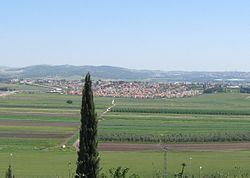Local time Friday 6:42 AM | Founded 1925 | |
 | ||
Weather 11°C, Wind E at 2 km/h, 89% Humidity | ||
Ramat Yishai (Hebrew: רָמַת יִשַּׁי, Jesse's Heights; Arabic: رمات يشاي) is a town in the Northern District of Israel, located on the side of the Haifa–Nazareth road about 4 kilometres (2.5 mi) eastern to Kiryat Tivon. It achieved local council status in 1958. In 2015 it had a population of 7,478; the vast majority of residents are Jewish.
Contents
- Map of Ramat Yishai Israel
- History
- Ottoman era
- British Mandate era
- State of Israel
- Notable residents
- References
Map of Ramat Yishai, Israel
History
Archaeological remnants have been found from Middle Bronze Age I (a tomb) and the Roman, Byzantine, Umayyad and Abbasid eras. Of particular interest, was a zoomorphic vessel of glass, dating to the Umayyad era. Remains from the Crusades, as well as from the Mamluk era has also been found here.
Ottoman era
During the Ottoman era was here a Muslim village called Jeida. The village appeared as Geida on the map which Pierre Jacotin compiled in 1799.
In 1859, the village of Jeida was estimated to have 120 inhabitants, and the tillage was 20 feddans. In 1875 Victor Guérin found rock-cut cisterns here. In 1881, the Palestine Exploration Fund's Survey of Western Palestine (SWP) found that Jeida was much like Al-Harithiyah, but with houses of adobe. A spring existed 3/4 of a mile to the west. One of the most known buildings in the village is called "the Khan" (hostel in Arabic), a 1909 building with surrounding walls. The logo of the village consists of this Ottoman-era building with a palm tree next to it. The town hall flies 2 logo-on-bedsheet flags with this emblem in dark blue on a light blue and a yellow field, respectively.
British Mandate era
In the 1922 census of Palestine conducted by the British Mandate authorities, Jaida had a total population of 327; 324 Muslims and 3 Christians; of which two were Roman Catholics and one was Melchite.
In 1925 a Zionist organisation purchased 15,000 dunams in Jaida, including the Khan building, from the heirs of the Twsiny family (partners of the Sursuk family of Beirut.) At the time, there were 110 families living in the village.
At the time of the 1931 census, Jaida had 29 occupied houses and a population of 77 Jews, 2 Christians, and 33 Muslims; a total of 115.
The land, on the western edge of the Jezreel Valley, which belonged to the village of Jida, was bought by a group of American Zionists in the early 1920s. It was renamed Manor and then Yefe Nof, but was almost deserted after a few years. In 1925, the British philanthropist Yisrael Yehudah Adler saved it from bankruptcy and it was renamed in his honour shortly thereafter. Among the founders of the village were 50 families from Łódź and Białystok, who built a textile factory in the village. Weaving and textile manufacturing were, therefore, the local trades.
During the Arab Revolt the isolated Jewish population was subject to constant attacks, sniper fire and ambushes from armed militias of local Arabs. On 12 October 1936 Mordechai Feldman was ambushed and killed. On the night of 5 June 1938, armed Arabs attacked the Jews in the village, killed one of the volunteer notrim, Zvi Levine, wounded another, and burned down the textile factory.
By 1945, Ramat Yishai had 50 residents, all Jewish. It was noted that it was previously called Jeida. The first residents were Yemenite Jews, later joined by Jewish refugees from Romania.
State of Israel
Since the 1990s, Ramat Yishai has undergone rapid development. In 2010, the population was estimated at close to 7,000 people, with 1,800 households at the high end of the socioeconomic scale.
